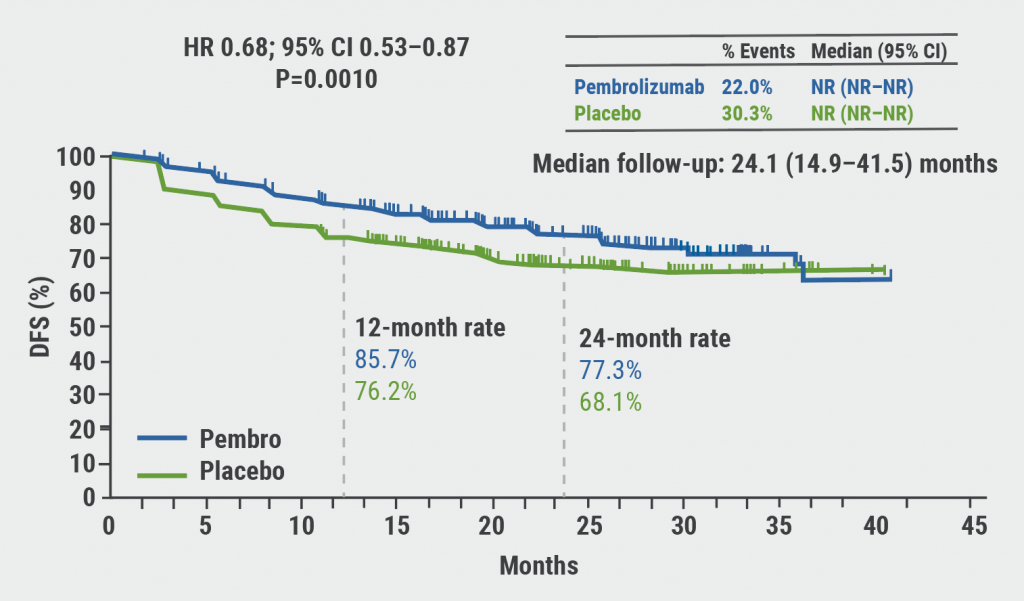Approaches derived from fundamental tumour biology have demonstrated clinical efficacy, including fibroblast growth factor receptor (FGFR) inhibitors and antibody-drug conjugates. In muscle-invasive bladder cancer (MIBC), somatic genetic alterations are potentially targetable, including mutations in FGFR3, HHRm, HER2, components of angiogenesis, and the epigenome.
FGFR3 mutation is associated with luminal-papillary urothelial carcinoma; 70% of this pathology harbours somatic activating mutations, 20% exhibits gene rearrangement, and 10% overexpresses FGFR3. Specific FGFR inhibitors tested in urothelial cancer include BGJ398, rogaratinib, and erdafitinib. In the BLC2001 phase 2 trial, 99 heavily pre-treated FGFR3-mutant patients with complex comorbidities received erdafitinib. Despite being an extremely poor-prognosis group, 3% achieved a complete response and 37% a partial response [2]. The confirmed response rate was even better in the patients who had previously failed immunotherapy: 59%. The median duration of progression-free survival was 5.5 months, and the median duration of overall survival was 13.8 months. The THOR study is a phase 3 study currently enrolling patients with metastatic urothelial carcinoma, identifying those who have previously been treated with immunotherapy. Those who have been treated with immunotherapy are then randomised to erdafitinib versus chemotherapy and those without prior immunotherapy are randomised to erdafitinib versus pembrolizumab.
Antibody-drug conjugates showing promise include enfortumab vedotin in nectin-4-expressing urothelial carcinoma. In the EV-101 phase 1, dose-escalation/expansion trial, 112 patients treated with single-agent enfortumab vedotin showed an objective response rate of 43%, with a median overall survival of 12.3 months. The EV-301 phase 3 trial randomised patients that have previously received prior platinum and immunotherapy to either enfortumab vedotin or to taxane, vinflunine, or paclitaxel with a primary outcome of overall survival. This trial has completed enrolment and is awaiting data maturity. The combination of enfortumab vedotin plus pembrolizumab has shown activity in patients regardless of programmed death ligand (PD-L)1 expression. The EV-302 study will further evaluate this combination. In addition, sacituzumab govitecan has been investigated in the phase 2 TROPHY-U-01 study with metastatic urothelial carcinoma, and resulted in 74% of patients showing target lesion reduction.
Inhibiting vascular endothelial growth factor (VEGF) has also been explored. Anti-VEGF agent bevacizumab did not improve overall survival in combination with chemotherapy in initial studies, but a VEGF receptor-2 inhibitor, ramucirumab, might show clinical benefit when combined with docetaxel, as tested in the RANGE study. Namely, the median progression-free survival (i.e. the primary endpoint) was significantly prolonged in patients treated with ramucirumab plus docetaxel versus placebo plus docetaxel (4.1 vs 2.8 months; HR 0.757; 95% CI 0.607-0.943).
In conclusion, FGFR inhibitors and antibody-drug conjugates remain the most promising avenues beyond immunotherapy, but there are some alternative options that require more data. Prof. Loriot suggested that hot topics are how to (i) combine these agents with immunotherapy, (ii) investigate the early stage of the disease (i.e. neoadjuvant and adjuvant setting), (iii) investigate in patients with non-muscle invasive bladder cancer, and (iv) better understand the mechanisms of primary and acquired resistance.
- Loriot Y, et al. EAU20 Virtual Congress, 17-26 July 2020, State-of-the-art-lecture.
- Loriot Y, et al. N Engl J Med 2019;381:338-348.
Posted on
Previous Article
« KEYNOTE-426: no QoL differences pembrolizumab + axitinib versus sunitinib Next Article
Nadofaragene firadenovec effective in BCG-unresponsive papillary NMIBC »
« KEYNOTE-426: no QoL differences pembrolizumab + axitinib versus sunitinib Next Article
Nadofaragene firadenovec effective in BCG-unresponsive papillary NMIBC »
Table of Contents: EAU 2020
Featured articles
Surgical Techniques and Safety
The new adjustable artificial sphincter victo: Surgical technique and results after a follow-up of more than one year
New urosepsis data from the SERPENS study
Stones
Intra-operative cone-beam computed tomography for detecting residual stones in percutaneous nephrolithotomy
Pressure and temperature: do high-power lasers pose a threat?
Radiation stewardship for patient and endourologist
New lithotripter data: improved stone clearance
Renal Cancer
Beyond the limits of ultrasound: Three dimensional augmented reality robot assisted partial nephrectomy (3D AR-RAPN) for complex renal masses
Imaging guided surgery with augmented reality for robotic partial nephrectomy
KEYNOTE-426: no QoL differences pembrolizumab + axitinib versus sunitinib
Debate: upfront cytoreductive nephrectomy or not?
Robotic-assisted partial nephrectomy: lower morbidity
Bladder Cancer
Reduced BCG frequency, faster NMIBC recurrence
Nadofaragene firadenovec effective in BCG-unresponsive papillary NMIBC
Understanding MIBC biology for novel treatment options
Prostate Cancer & Imaging
Transperineal laser ablation of prostate
Prostatectomy: R-LRPE better than LRPE for continence
PSMA PET-CT staging is 27% more accurate
Docetaxel + hormonal therapy: improved prostate cancer PFS
ARAMIS subgroup analysis: darolutamide benefits across PSADT groups
Large patient-driven survey reveals QoL issues after prostate cancer treatment
Targeting steroid sulphatase in resistant prostate cancer cells
Good tolerance of post-RP radiotherapy ± short-term ADT
BPH & LUTS
Minimizing post-operative stress urinary incontinence after HoLEP: Our preliminary experience and short-term results of ‘’En Bloc’’ technique with early apical release
LUTS 2-year outcomes: aquablation versus TURP
HoLEP versus PVP in prospective randomised trial
Testis Cancer & Andrology
Peyronie’s disease: surgical options
Infertility and testis cancer risk: causal or association?
32% more men complain of reduced sex drive in 2019 versus 2009
© 2024 Medicom Medical Publishers. All rights reserved. Terms and Conditions | Privacy Policy
HEAD OFFICE
Laarderhoogtweg 25
1101 EB Amsterdam
The Netherlands
T: +31 85 4012 560
E: publishers@medicom-publishers.com


